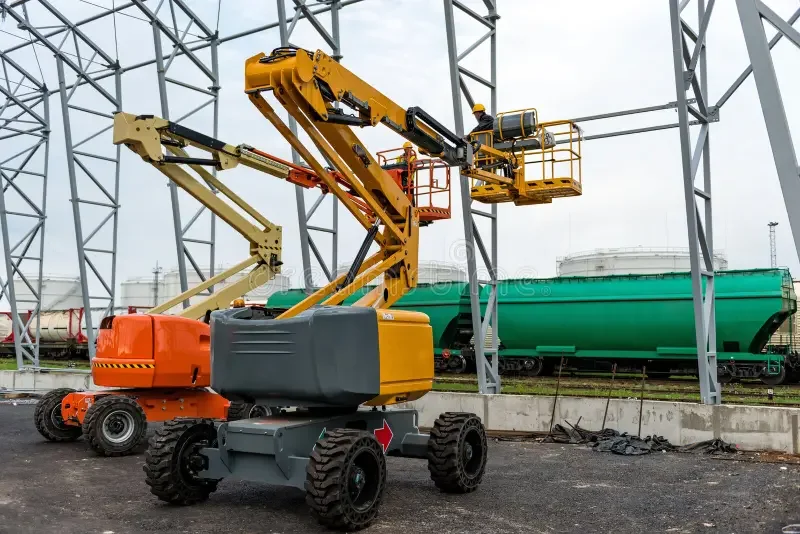Mobile Equipment Safety: Protecting Workers and Preventing Accidents
Mobile equipment is a powerful force on construction and industrial sites. From forklifts and loaders to cranes and haul trucks, these machines move projects forward but they also bring serious safety risks when not managed properly. Every year, mobile equipment contributes to fatalities, struck-by incidents, and caught-between hazards that could have been prevented with stronger training and controls.
Mobile equipment is one of the biggest hazards on construction and industrial sites. From forklifts to bulldozers, these machines move tons of material daily, but they also bring significant risks. According to OSHA, struck-by incidents remain one of the “Fatal Four” leading causes of worker deaths in construction, and mobile equipment is a major contributor.
For contractors, prioritizing mobile equipment safety isn’t just about compliance, it’s about protecting workers, reducing liability, and ensuring projects run smoothly.
The Hidden Dangers of Mobile Equipment
Mobile equipment accidents often stem from the same core issues: blind spots, poor communication, and inadequate training. While machines like cranes, skid steers, and loaders are powerful tools, they can quickly become deadly if not operated or maintained correctly.
Some of the most common hazards include:
Struck-By Incidents – Workers on foot can be hit by moving equipment, especially in congested job sites.
Rollovers – Equipment overturns remain a leading cause of operator fatalities.
Caught-In/Between Hazards – Workers can be pinned between equipment and other objects, leading to severe injuries.
Maintenance Risks – Improper lockout/tagout during repairs puts mechanics and operators at risk.
According to NIOSH, construction workers are more likely to be killed by mobile equipment incidents than many other workplace hazards, underscoring the need for proactive safety measures.
Why Training Matters
Even the best equipment is only as safe as the operator behind it. Unfortunately, many workers are placed on machines without receiving proper training. Contractors often rely on “experience” rather than structured education, which leaves gaps in safety awareness.
Key challenges include:
Inconsistent Operator Training – Some workers are trained on one type of equipment but asked to operate another.
Language Barriers – Safety instructions aren’t always delivered in the worker’s preferred language.
Overconfidence – Experienced workers may underestimate hazards, skipping pre-use inspections or operating without spotters.
Modern, ongoing training is essential to combat these issues. That means blending traditional instruction with hands-on learning and leveraging digital platforms for easy access to refresher courses.
👉 At Kelly Safety, we provide contractors with the flexible online safety training they need to keep workers certified and job-ready.
Best Practices for Mobile Equipment Safety
Conduct Pre-Use Inspections
Operators should check brakes, tires, hydraulics, lights, alarms, and seatbelts before every shift. Small issues often escalate into major hazards when overlooked.Use Spotters and Signals
Clear, standardized hand signals and dedicated spotters prevent blind-spot accidents and improve communication in noisy environments.Maintain Clear Work Zones
Designate equipment-only areas and pedestrian walkways to reduce struck-by risks. According to the National Safety Council, simple separation of workers and equipment significantly reduces incidents.Wear Proper PPE
High-visibility clothing, steel-toe boots, and helmets give workers an added layer of protection around moving equipment.Plan for Rollovers
Always use seatbelts, avoid steep slopes, and follow manufacturer load limits. Rollovers are often preventable with cautious operation.Lockout/Tagout During Maintenance
Equipment should never be serviced while energized. Proper lockout/tagout procedures save lives.
The Role of Technology in Equipment Safety
The construction industry is adopting new tools to make equipment safety smarter and more efficient:
Collision Avoidance Systems – Sensors and cameras alert operators to nearby workers or obstacles.
GPS Tracking – Monitors equipment movement, reducing unauthorized use and improving fleet management.
Wearable Tech – Smart helmets and vests can detect proximity to moving equipment and send real-time alerts.
While technology enhances safety, it can’t replace proper training. Workers need to understand both the capabilities and limitations of these systems.
Building a Culture of Safety
Creating a safe job site requires more than rules—it takes a cultural shift where safety becomes second nature. This includes:
Leadership Commitment – Supervisors must set the tone by modeling safe behavior.
Open Communication – Workers should feel comfortable reporting hazards without fear of retaliation.
Continuous Training – Safety isn’t one-and-done. Refresher courses and toolbox talks keep workers sharp.
At Kelly Safety, we believe effective communication and consistent training are the foundation of a safe workplace. When contractors invest in safety culture, they protect both their workers and their bottom line.
Conclusion: Protecting Workers, Strengthening Businesses
Mobile equipment will always be a critical part of construction and industrial operations but it doesn’t have to be one of the biggest hazards. With proactive training, effective communication, and smart use of technology, contractors can significantly reduce risks on the job site.
By modernizing training, enforcing best practices, and leveraging resources like OSHA’s mobile equipment guidelines, companies can stay compliant and save lives.
👉 Ready to improve your workforce training? Visit KellySafety.com/promo for contractor-focused safety solutions that keep your team certified and safe.

